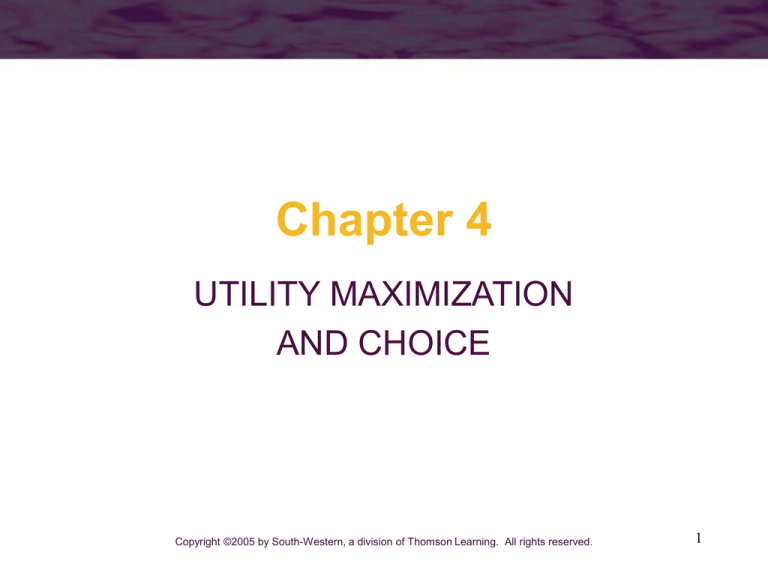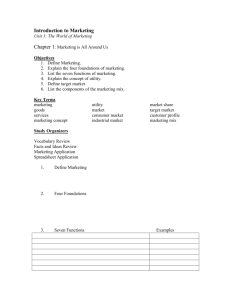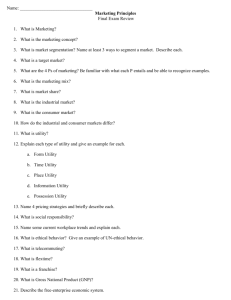
Chapter 4
UTILITY MAXIMIZATION
AND CHOICE
Copyright ©2005 by South-Western, a division of Thomson Learning. All rights reserved.
1
Complaints about the
Economic Approach
• No real individuals make the kinds of
“lightning calculations” required for utility
maximization
• The utility-maximization model predicts
many aspects of behavior
• Thus, economists assume that people
behave as if they made such calculations
2
Complaints about the
Economic Approach
• The economic model of choice is
extremely selfish because no one has
solely self-centered goals
• Nothing in the utility-maximization
model prevents individuals from deriving
satisfaction from “doing good”
3
Optimization Principle
• To maximize utility, given a fixed amount
of income to spend, an individual will buy
the goods and services:
– that exhaust his or her total income
– for which the psychic rate of trade-off
between any goods (the MRS) is equal to
the rate at which goods can be traded for
one another in the marketplace
4
A Numerical Illustration
• Assume that the individual’s MRS = 1
– willing to trade one unit of x for one unit of
y
• Suppose the price of x = $2 and the
price of y = $1
• The individual can be made better off
– trade 1 unit of x for 2 units of y in the
marketplace
5
The Budget Constraint
• Assume that an individual has I dollars
to allocate between good x and good y
pxx + pyy I
Quantity of y
I
py
If all income is spent
on y, this is the amount
of y that can be purchased
The individual can afford
to choose only combinations
of x and y in the shaded
triangle
If all income is spent
on x, this is the amount
of x that can be purchased
I
px
Quantity of x
6
First-Order Conditions for a
Maximum
• We can add the individual’s utility map
to show the utility-maximization process
Quantity of y
The individual can do better than point A
by reallocating his budget
A
The individual cannot have point C
because income is not large enough
C
B
U3
U2
U1
Point B is the point of utility
maximization
Quantity of x
7
First-Order Conditions for a
Maximum
• Utility is maximized where the indifference
curve is tangent to the budget constraint
Quantity of y
slope of budget constraint
B
px
py
slope of indifferen ce curve
U2
dy
dx U constant
px
dy
MRS
py
dx U constant
Quantity of x
8
Second-Order Conditions for a
Maximum
• The tangency rule is only necessary but
not sufficient unless we assume that MRS
is diminishing
– if MRS is diminishing, then indifference curves
are strictly convex
• If MRS is not diminishing, then we must
check second-order conditions to ensure
that we are at a maximum
9
Second-Order Conditions for a
Maximum
• The tangency rule is only a necessary
condition
– we need MRS to be diminishing
Quantity of y
There is a tangency at point A,
but the individual can reach a higher
level of utility at point B
B
A
U2
U1
Quantity of x
10
Corner Solutions
• In some situations, individuals’ preferences
may be such that they can maximize utility
by choosing to consume only one of the
goods
Quantity of y
U1
U2
At point A, the indifference curve
is not tangent to the budget constraint
U3
Utility is maximized at point A
A
Quantity of x
11
The n-Good Case
• The individual’s objective is to maximize
utility = U(x1,x2,…,xn)
subject to the budget constraint
I = p1x1 + p2x2 +…+ pnxn
• Set up the Lagrangian:
L = U(x1,x2,…,xn) + (I - p1x1 - p2x2 -…- pnxn)
12
The n-Good Case
• First-order conditions for an interior
maximum:
L/x1 = U/x1 - p1 = 0
L/x2 = U/x2 - p2 = 0
•
•
•
L/xn = U/xn - pn = 0
L/ = I - p1x1 - p2x2 - … - pnxn = 0
13
Implications of First-Order
Conditions
• For any two goods,
U / xi
pi
U / x j p j
• This implies that at the optimal
allocation of income
pi
MRS ( xi for x j )
pj
14
Interpreting the Lagrangian
Multiplier
U / x1 U / x2
U / x n
...
p1
p2
pn
MUx1
p1
MUx2
p2
...
MUxn
pn
• is the marginal utility of an extra dollar
of consumption expenditure
– the marginal utility of income
15
Interpreting the Lagrangian
Multiplier
• At the margin, the price of a good
represents the consumer’s evaluation of
the utility of the last unit consumed
– how much the consumer is willing to pay
for the last unit
pi
MUxi
16
Corner Solutions
• When corner solutions are involved, the
first-order conditions must be modified:
L/xi = U/xi - pi 0 (i = 1,…,n)
• If L/xi = U/xi - pi < 0, then xi = 0
• This means that
U / xi MUxi
pi
– any good whose price exceeds its marginal
value to the consumer will not be purchased
17
Cobb-Douglas Demand
Functions
• Cobb-Douglas utility function:
U(x,y) = xy
• Setting up the Lagrangian:
L = xy + (I - pxx - pyy)
• First-order conditions:
L/x = x-1y - px = 0
L/y = xy-1 - py = 0
L/ = I - pxx - pyy = 0
18
Cobb-Douglas Demand
Functions
• First-order conditions imply:
y/x = px/py
• Since + = 1:
pyy = (/)pxx = [(1- )/]pxx
• Substituting into the budget constraint:
I = pxx + [(1- )/]pxx = (1/)pxx
19
Cobb-Douglas Demand
Functions
• Solving for x yields
I
x*
px
• Solving for y yields
I
y*
py
• The individual will allocate percent of
his income to good x and percent of
his income to good y
20
Cobb-Douglas Demand
Functions
• The Cobb-Douglas utility function is
limited in its ability to explain actual
consumption behavior
– the share of income devoted to particular
goods often changes in response to
changing economic conditions
• A more general functional form might be
more useful in explaining consumption
decisions
21
CES Demand
• Assume that = 0.5
U(x,y) = x0.5 + y0.5
• Setting up the Lagrangian:
L = x0.5 + y0.5 + (I - pxx - pyy)
• First-order conditions:
L/x = 0.5x -0.5 - px = 0
L/y = 0.5y -0.5 - py = 0
L/ = I - pxx - pyy = 0
22
CES Demand
• This means that
(y/x)0.5 = px/py
• Substituting into the budget constraint,
we can solve for the demand functions
x*
I
px
px [1 ]
py
y*
I
py
py [1 ]
px
23
CES Demand
• In these demand functions, the share of
income spent on either x or y is not a
constant
– depends on the ratio of the two prices
• The higher is the relative price of x (or
y), the smaller will be the share of
income spent on x (or y)
24
CES Demand
• If = -1,
U(x,y) = -x -1 - y -1
• First-order conditions imply that
y/x = (px/py)0.5
• The demand functions are
x*
I
py
px 1
px
0.5
y*
I
p
py 1 x
py
0 .5
25
CES Demand
• If = -,
U(x,y) = Min(x,4y)
• The person will choose only combinations
for which x = 4y
• This means that
I = pxx + pyy = pxx + py(x/4)
I = (px + 0.25py)x
26
CES Demand
• Hence, the demand functions are
I
x*
px 0.25 py
I
y*
4 p x py
27
Indirect Utility Function
• It is often possible to manipulate firstorder conditions to solve for optimal
values of x1,x2,…,xn
• These optimal values will depend on the
prices of all goods and income
x*1 = x1(p1,p2,…,pn,I)
x*2 = x2(p1,p2,…,pn,I)
•
•
•
x*n = xn(p1,p2,…,pn,I)
28
Indirect Utility Function
• We can use the optimal values of the xs
to find the indirect utility function
maximum utility = U(x*1,x*2,…,x*n)
• Substituting for each x*i, we get
maximum utility = V(p1,p2,…,pn,I)
• The optimal level of utility will depend
indirectly on prices and income
– if either prices or income were to change,
the maximum possible utility will change
29
The Lump Sum Principle
• Taxes on an individual’s general
purchasing power are superior to taxes
on a specific good
– an income tax allows the individual to
decide freely how to allocate remaining
income
– a tax on a specific good will reduce an
individual’s purchasing power and distort
his choices
30
The Lump Sum Principle
• A tax on good x would shift the utilitymaximizing choice from point A to point B
Quantity of y
B
A
U1
U2
Quantity of x
31
The Lump Sum Principle
• An income tax that collected the same
amount would shift the budget constraint
to I’
Quantity of y
Utility is maximized now at point
C on U3
I’
A
B
C
U3 U1
U2
Quantity of x
32
Indirect Utility and the
Lump Sum Principle
• If the utility function is Cobb-Douglas with
= = 0.5, we know that
I
x*
2 px
I
y*
2 py
• So the indirect utility function is
V ( px , py , I ) (x*) (y*)
0.5
0.5
I
2px0.5 py0.5
33
Indirect Utility and the
Lump Sum Principle
• If a tax of $1 was imposed on good x
– the individual will purchase x*=2
– indirect utility will fall from 2 to 1.41
• An equal-revenue tax will reduce income to
$6
– indirect utility will fall from 2 to 1.5
34
Indirect Utility and the
Lump Sum Principle
• If the utility function is fixed proportions
with U = Min(x,4y), we know that
I
x*
px 0.25 py
I
y*
4 p x py
• So the indirect utility function is
I
V ( px , py , I ) Min( x *,4 y *) x*
px 0.25 py
4
I
4y *
4 px py px 0.25 py
35
Indirect Utility and the
Lump Sum Principle
• If a tax of $1 was imposed on good x
– indirect utility will fall from 4 to 8/3
• An equal-revenue tax will reduce income to
$16/3
– indirect utility will fall from 4 to 8/3
• Since preferences are rigid, the tax on x
does not distort choices
36
Expenditure Minimization
• Dual minimization problem for utility
maximization
– allocating income in such a way as to achieve
a given level of utility with the minimal
expenditure
– this means that the goal and the constraint
have been reversed
37
Expenditure Minimization
• Point A is the solution to the dual problem
Expenditure level E2 provides just enough to reach U1
Quantity of y
Expenditure level E3 will allow the
individual to reach U1 but is not the
minimal expenditure required to do so
A
Expenditure level E1 is too small to achieve U1
U1
Quantity of x
38
Expenditure Minimization
• The individual’s problem is to choose
x1,x2,…,xn to minimize
total expenditures = E = p1x1 + p2x2 +…+ pnxn
subject to the constraint
utility = U1 = U(x1,x2,…,xn)
• The optimal amounts of x1,x2,…,xn will
depend on the prices of the goods and the
required utility level
39
Expenditure Function
• The expenditure function shows the
minimal expenditures necessary to
achieve a given utility level for a particular
set of prices
minimal expenditures = E(p1,p2,…,pn,U)
• The expenditure function and the indirect
utility function are inversely related
– both depend on market prices but involve
different constraints
40
Two Expenditure Functions
• The indirect utility function in the two-good,
Cobb-Douglas case is
V ( px , py , I )
I
2px0.5 py0.5
• If we interchange the role of utility and
income (expenditure), we will have the
expenditure function
E(px,py,U) = 2px0.5py0.5U
41
Two Expenditure Functions
• For the fixed-proportions case, the indirect
utility function is
I
V ( px , py , I )
px 0.25 py
• If we again switch the role of utility and
expenditures, we will have the
expenditure function
E(px,py,U) = (px + 0.25py)U
42
Properties of Expenditure
Functions
• Homogeneity
– a doubling of all prices will precisely double
the value of required expenditures
• homogeneous of degree one
• Nondecreasing in prices
– E/pi 0 for every good, i
• Concave in prices
43
Concavity of Expenditure
Function
At p*1, the person spends E(p*1,…)
E(p1,…)
If he continues to buy
the same set of goods as
p*1 changes, his
expenditure function
would be Epseudo
Epseudo
E(p1,…)
E(p*1,…)
Since his consumption
pattern will likely change,
actual expenditures will
be less than Epseudo such
as E(p1,…)
p*1
p1
44
Important Points to Note:
• To reach a constrained maximum, an
individual should:
– spend all available income
– choose a commodity bundle such that the
MRS between any two goods is equal to
the ratio of the goods’ prices
• the individual will equate the ratios of the
marginal utility to price for every good that is
actually consumed
45
Important Points to Note:
• Tangency conditions are only firstorder conditions
– the individual’s indifference map must
exhibit diminishing MRS
– the utility function must be strictly quasiconcave
46
Important Points to Note:
• Tangency conditions must also be
modified to allow for corner solutions
– the ratio of marginal utility to price will be
below the common marginal benefitmarginal cost ratio for goods actually
bought
47
Important Points to Note:
• The individual’s optimal choices
implicitly depend on the parameters of
his budget constraint
– choices observed will be implicit functions
of prices and income
– utility will also be an indirect function of
prices and income
48
Important Points to Note:
• The dual problem to the constrained
utility-maximization problem is to
minimize the expenditure required to
reach a given utility target
– yields the same optimal solution as the
primary problem
– leads to expenditure functions in which
spending is a function of the utility target
and prices
49








